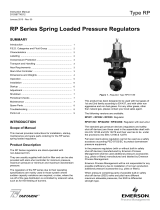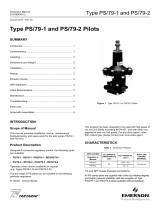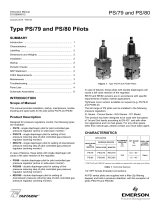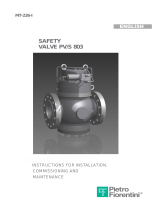
A/100
Safe Use Guide
SG0095GB Rev.06
Year of Manufacture 2008
2
Overpressure Protection
The recommended maximum allowable pressures are
stamped on the regulator nameplate.
If actual version hasn’t a built-in safety shut-off device,
some type of overpressure protection is needed if the
actual outlet pressure exceeds the actual maximum
operating outlet pressure rating.
Overpressure protection should also be provided if the
regulator inlet pressure is greater than the maximum
operating inlet pressure.
Downstream side pressure after possible built-in SSD’s
intervention shall stay within the actual maximum
operating set-up range to avoid anomalous back
pressures that can damage the SSD’s pilot.
Downstream overpressure protection shall be also
provided if the SSD outlet pressure can be greater than
the PS of the SSD pilot (differential strength type).
Regulator operation below the maximum pressure
limitations does not preclude the possibility of damage
from external sources or debris in the line.
The regulator should be inspected for damage after any
overpressure condition.
Transport and Handling
Established transport and handling procedures shall be
followed to avoid any damage on the pressure containing
parts by shocks or anomalous stresses.
Built-up sensing lines and pressure accessories shall to
be protected by shocks or anomalous stresses.
Installation
! WARNING !
Installation shall be in accordance with national
standard for material use limitations in gas
pressure reducing stations.
Only qualified personnel should install or service
a regulator. Regulators should be installed,
operated, and maintained in accordance with
international and applicable codes and
regulations, and O.M.T. Tartarini instructions.
If the regulator vents fluid or a leak develops in
the system, it indicates that service is required.
Failure to take the regulator out of service
immediately may create a hazardous condition.
Personal injury, equipment damage, or leakage
due to escaping fluid or bursting of pressure-
containing parts may result if this regulator is
over pressured or is installed where service
conditions could exceed the limits given in the
Specifications section, or where conditions
exceed any ratings of the adjacent piping or
piping connections.
To avoid such injury or damage, provide
pressure-relieving or pressure-limiting devices
(as required by the appropriate code, regulation,
or standard) to prevent service conditions from
exceeding limits.
Additionally, physical damage to the regulator
could result in personal injury and property
damage due to escaping fluid.
To avoid such injury and damage, install the
regulator in a safe location.
Before installation, check shall be done if service
conditions are consistent with use limitations and
if pilot set-up of possible built-in safety shut-off
device are in accordance with service conditions
of protected equipment.
All means for venting have to be provided in the
assemblies where the pressure equipment are
installed (ENs 12186 & 12279).
All means for draining have to be provided in the
equipment installed before regulators & shut-off
devices (ENs 12186 & 12279).
Further the ENs 12186 & 12279, where this product is
used:
− provide the cathodic protection and electrical
isolation to avoid any corrosion and
− in accordance with clause 7.3/7.2 of aforesaid
standards, the gas shall be cleaned by proper
filters/separators/scrubbers to avoid any technical
& reasonable hazard of erosion or abrasion for
pressure containing parts.
Pressure equipment in subject shall be installed in non-
seismic area and hasn’t to undergo fire and thunderbolt
action.
Clean out all pipelines before installation of the regulator
and check to be sure the regulator has not been damaged
or has collected foreign material during shipping.
Apply pipe compound to the male pipe threads.
Install the regulator in any position desired, unless
otherwise specified, but be sure flow through the body is
in the direction indicated by the arrow on the body.
Installation must be done avoiding anomalous stresses on
the body and using suitable joint means according
equipment dimensions and service conditions.
For a correct and safe use of the connections check also
Instruction Manual and Bulletin before installation.
User has to check and carry out any protection suitable for
assembly’s specific environment.
Note: It is important that the regulator be installed so
that the vent hole in the spring case is unobstructed at
all times. For outdoor installations, the regulator should
be located away from vehicular traffic and positioned
so that water, ice, and other foreign materials cannot
enter the spring case through the vent. Avoid placing
the regulator beneath eaves or downspouts, and be
sure it is above the probable snow level.
















